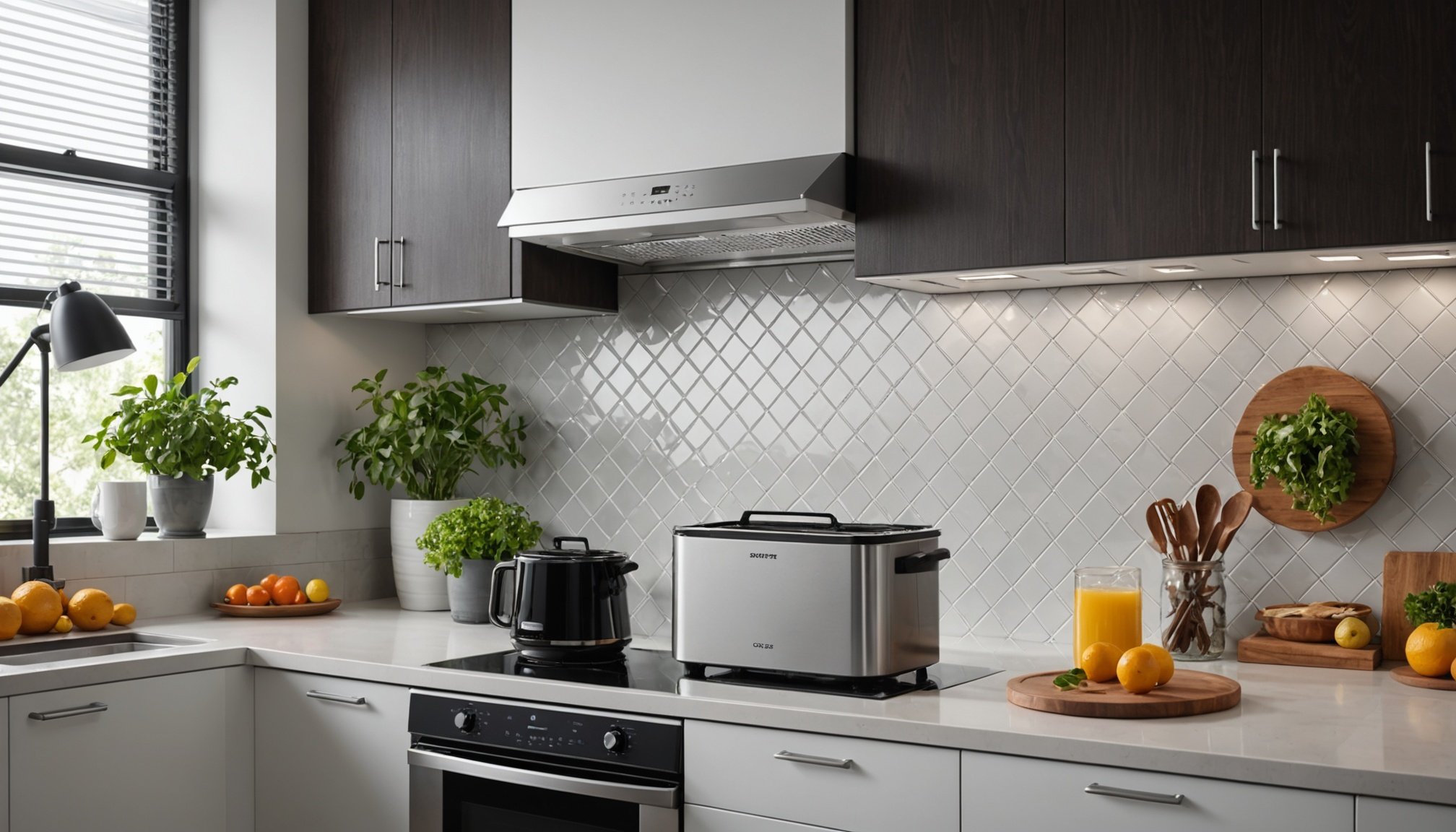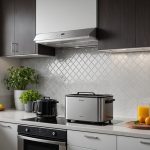Overview of UV-C Air Purifiers
UV-C air purifiers are innovative devices designed to enhance air quality improvement. They operate by emitting ultraviolet-C light, which penetrates and disrupts the DNA or RNA of microorganisms, rendering them inactive. This makes them particularly effective in neutralising bacteria, viruses, and fungi in the air. These purifiers can be a critical addition, especially in areas like the kitchen, where maintaining kitchen health is crucial for family well-being.
Kitchens can harbour various common harmful contaminants. Movements like cooking release particulate matter and volatile organic compounds (VOCs), often found in cleaning agents or cooking fumes, which can contribute to poor air quality. UV-C air purifiers help mitigate these risks by ensuring these pollutants are addressed before they circulate further in the home environment.
Have you seen this : Transform your kitchen with a yogurt maker: enjoy guilt-free indulgence and health benefits!
Additionally, understanding the potential impact of these contaminants on respiratory health underscores the necessity of keeping kitchen air clean. By using a UV-C air purifier, there’s an effective layer of defence against these invisible threats. Regular use ensures not only a healthier kitchen atmosphere but also encourages overall air quality improvement throughout the household. This approach to kitchen health can lead to a more pleasant and safe cooking environment.
Effectiveness of UV-C Technology
UV-C light is a powerful tool in purification technology, renowned for its ability to eliminate a wide range of contaminants. At its core, UV-C works by emitting light at a specific wavelength (around 254 nm) that penetrates the cell walls of airborne microorganisms, disrupting their DNA and effectively rendering them harmless. This unique mechanism is celebrated for its precision in targeting pathogens without leaving behind chemical residues, unlike some traditional methods.
Have you seen this : Enhance food safety and nutritional value in your kitchen with uv light sanitizers
Numerous studies have showcased the effectiveness of UV-C technology in destroying specific pathogens, such as bacteria and viruses, including the influenza virus and coronaviruses. For instance, research conducted in controlled settings has demonstrated over 99% efficacy in inactivating these contaminants, indicating significant potential for improving indoor air quality.
When comparing UV-C technology to traditional air purification methods like HEPA filters or activated carbon, UV-C distinguishes itself by targeting microscopic contaminants that might escape mechanical filtration. While HEPA filters physically trap particles, UV-C light actively inactivates them, offering a complementary approach to air purification. Particularly in settings where maintaining sterile environments is critical, such as hospitals or laboratories, UV-C technology provides an invaluable addition to air purification strategies, ensuring comprehensive protection from a broad spectrum of airborne threats.
Health Advantages of Using UV-C Air Purifiers
UV-C air purifiers offer several health benefits by targeting airborne allergens and irritants. These devices help to reduce allergens, which can ease symptoms for those suffering from allergies. By breaking down particles like pollen, dust, and pet dander, individuals experience fewer allergic reactions, leading to improved daily comfort and productivity.
Maintaining excellent respiratory health is another key advantage of UV-C air purifiers. The constant purification of air helps to eliminate a range of contaminants, including mould spores and bacteria. These improvements in air quality can prevent respiratory illnesses, such as asthma attacks and other chronic conditions exacerbated by poor air. A cleaner environment can lead to reduced incidences of coughing, sneezing, and other respiratory issues.
Furthermore, using UV-C air purifiers is linked to enhanced overall wellness. Breathing in clean air supports better sleep patterns, as the absence of irritants allows for more restful sleep. Additional health benefits may include boosted immunity and improved mental clarity, providing an overarching sense of wellbeing. Whether employed at home or in the workplace, the benefits of cleaner air resonate through improved physical health and a more invigorating environment.
Comparing UV-C Air Purifiers to Other Methods
In today’s market, choosing the right air purifier involves understanding various technologies and their unique merits. This section focuses on UV-C air purifiers in comparison to other popular air purification techniques.
UV-C vs. HEPA Filters
UV-C air purifiers and HEPA filters each have distinct mechanisms for cleaning the air. While UV-C purifiers utilise ultraviolet light to neutralise microorganisms, HEPA filters physically capture particles as small as 0.3 microns. This makes HEPA particularly effective for allergens like dust mites and pollen. However, HEPA filters do not kill pathogens; they merely trap them.
UV-C vs. Activated Carbon Filters
Activated carbon filters focus on removing odours and chemical toxins rather than pathogens. They are complements rather than replacements for UV-C technology. Whereas UV-C purifiers are best for killing germs and bacteria, carbon filters excel at absorbing volatile organic compounds (VOCs).
UV-C vs. Ozone Generators
Comparing UV-C and ozone generators, the primary difference lies in safety. While UV-C purifiers safely eliminate airborne pathogens without producing ozone, ozone generators are controversial due to potential respiratory issues caused by ozone. Consider the cost-effectiveness and long-term maintenance requirements. UV-C lamps need periodic replacement, while ozone units may present hidden health costs.
Choosing the Right UV-C Air Purifier
When selecting air purifiers, it’s important to start with a clear understanding of the key features to consider. UV-C air purifiers focus primarily on using ultraviolet light to kill or inactivate microorganisms, so the strength and design of the UV-C lamp are critical. Make sure you’re aware of the lamp’s lifespan and replacement needs to avoid unexpected maintenance costs.
The importance of unit size and air flow rate cannot be understated in your buying decisions. Choosing the correct size means ensuring the unit effectively covers your living space without unnecessary energy consumption. A mismatch could lead to inefficient purification or excessive electricity bills.
As for UV-C lamp lifespan, manufacturers often specify the expected hours of operation. Some purifiers include indicators for when replacement is needed, which can be a helpful feature if you’re concerned about remembering maintenance tasks.
When buying a guide, ask questions like: Does it feature air quality sensors? Is it equipped with multiple speed settings? A good air purifier may also offer additional functionalities like activated carbon filters, which are excellent for odor removal. These aspects help tailor your choice to better meet your specific home environment and health requirements.
Maintenance Tips for UV-C Air Purifiers
Proper air purifier maintenance is essential to maximize efficiency and prolong the lifespan of your device. To achieve optimal performance, following a regular cleaning schedule is crucial. Start by wiping down the external surfaces to prevent dust accumulation, which can hinder performance. Clean or replace filters as per the manufacturer’s guidelines to keep your purifier functioning at its best.
The UV-C lamp is a vital component as it sterilizes the air. Over time, its effectiveness diminishes, even if it still emits light. Hence, replacing the UV-C lamp regularly is necessary to maintain the air purifier’s efficiency. Always refer to the manufacturer’s instructions for the recommended replacement interval. Keeping the lamp clean is also vital; a soft, dry cloth works best to avoid damage.
For enhanced air circulation, especially in the kitchen, it’s important to position the air purifier strategically. Avoid placing it directly on the floor or near obstacles that block airflow. Elevating it on a stable surface can improve efficiency. Consider the directionality of the airflow; facing the purifier towards areas with higher foot traffic often yields superior results. By maintaining your UV-C air purifier well, you ensure cleaner, healthier air for your home.
Evidence and Studies Supporting UV-C Use
Research into the effectiveness of UV-C light in air purifiers has revealed significant insights. Various UV-C research studies have focused on its ability to eliminate airborne pathogens. One notable study demonstrated that UV-C light could reduce microbial load by 90% in a controlled environment, showcasing its potential in improving air quality. Such scientific evidence provides compelling support for UV-C as a viable solution in pathogen reduction.
In addition to academic research, testimonials from users add a personal dimension to understanding the capabilities of UV-C technology. Many individuals have reported noticeable improvements in air quality within their homes. These real-world examples serve as practical illustrations of how UV-C air purifiers can impact daily life positively.
Expert endorsements further highlight the value of UV-C applications. Many health professionals recommend integrating UV-C systems, especially in healthcare and densely populated settings. Their recommendations stem from the robust scientific evidence supporting UV-C’s efficacy in mitigating the presence of harmful microorganisms.
Such a blend of UV-C research studies and user experiences reflects a growing consensus on the value of using UV-C technology for cleaner air, providing both empirical and anecdotal proof of its benefits.











